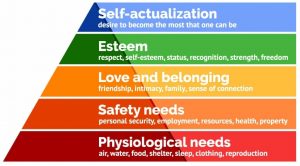Written by Ella Smith
Summer 2018
If we want all students to reach the top of Maslow’s Hierarchy of Needs (self-actualization), how can we expect them to achieve this without meeting the lowest level of the hierarchy (basic physiological needs)? In California, 20 percent of K-12 students are in poverty and 21 percent are food insecure. I have been an education policy nerd for years; in high school, I loved immersing myself in student government, leadership roles in my school district, and working with statewide educational non-profits. Through my food systems engagement project, I wanted to channel my longtime passion for education with my newfound passion for food justice. I delved into studying what programs and policies exist to ensure a students’ access to food with support from the Berkeley Food Institute.
Students are Hungry
With food insecurity being a strife for many college students, it’s understandable that college student hunger is finally catching the media’s attention. But K-12 student hunger seems much quieter, not making as many headlines. Students who are hungry struggle to focus on academics, and statistically don’t do as well as their peers who are not food insecure. There are a handful of federal programs aimed at combating student hunger with nutritious and low-cost meals. The National School Lunch Program (NSLP) and National School Breakfast (NSB) Program exist to ensure needy students are fed at school. However, 62 percent of eligible students do not participate in the free and reduced-price breakfast program, and 32 percent do not participate in the free and reduced-price lunch program. Even more so, 34 percent of eligible families do not receive food stamps through the Supplemental Nutrition Assistance Program (SNAP). With these federal services unused and funding left on the table, I sought to understand why.
More To Do
We are making strides, but these programs need to reach more Californians. It is hard to say why enrollment with the free-and-reduced meal program are not higher. USDA has proposed solutions to increasing enrollment, such as by offering application for school meal programs throughout the year, allowing online applications, and translating the application for non-English speakers.
In addition to English Learners and foster youth, low-income students (those eligible for free and reduced-price meal) are considered “high need students” in California. High need students are targeted for additional funds under California’s Local Control Funding Formula (LCFF). Collectively, these three groups represent 63 percent of California’s students. Most students (73.6 percent) are enrolled in districts where at least 40 percent of students were low income. Very few students (8.7 percent) attend school in districts where 20 percent or fewer of students were identified as eligible for free and reduced-price lunch. School nutrition programs help improve nutrition among vulnerable children. So enrolling more eligible students should be a priority for school districts and sites.
What’s Next?
I have compiled my research on a working document for community members, school officials, and students. It is important to realize how widespread hunger is among California’s young learners, and the detrimental effects this bring upon their mental health, physical well-being, development, and academic achievement. Our students will have a more equitable chance at self-actualization once hunger ameliorates. And while educational policies can tackle students’ hunger and symptoms of inequality, larger public policies that combat institutional inequality are necessary. We need public policies that prevent and combat hunger. I have come to realize how hunger is not egalitarian; some groups are disproportionately harmed by it.
Funding for this project was partially provided by the American Cultures Engaged Scholarship Program at UC Berkeley.

